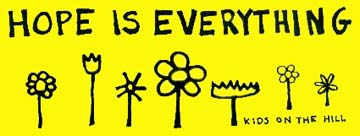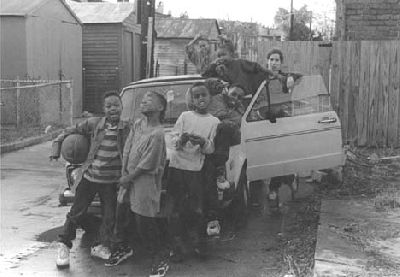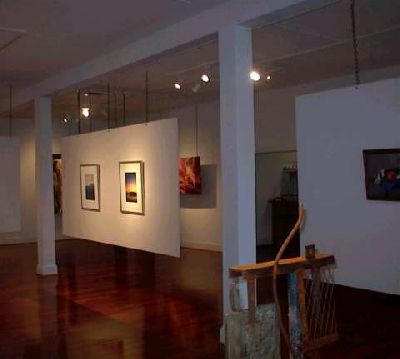Baltimore IMC : http://www.baltimoreimc.org
Commentary :: [none]
Baltimore's Kids on the Hill
What's a white woman doing hanging out with a crew of black kids in Baltimore's Reservoir Hill? Why? And what's the sushi connection?

The simple answer is that she's nurturing “Kids on the Hill,” an organization she founded that “creatively engages young people in artistic and educational experiences, which enables them to explore their potential while confronting and diminishing barriers of race, class, gender and age.” She is Rebecca Yenawine, a homeowner in Reservoir Hill since 1994.
The simple answer to “why” is not so simple. Rebecca says, “I wanted to grow; to undo my own racism; to build a community around me and I wanted [the kids] to be able to have kinder friendships and more access to the things they dreamed of.”

"Kids on the Hill" uses the arts, including animated video production, to engage young people in revitalizing their community.
Getting Involved with Kids on the Hill
Let me continue where most advocacy articles end. If Rebecca's “what and why” sounds intreaguing to you, consider getting involved. The Mentor Program takes a very flexible approach. Supported with guidance by social worker Nancy Himmelreich, you might consider spending an hour a week sharing mutual interests and becoming friends with a young person from Reservoir Hill.
Contact: nhimmelreich-AT-kidsonthehill.org
You can also participate on a periodic basis by helping out special projects. Occasionally they can use a hand do things like mosaic projects, or mural painting. Get on their e-mail list to keep open the option of joining the fun.
If making a time commitment isn't a good fit for you, perhaps you would consider making a financial donation to support Kids on the Hill's use of art, video and other creative avenues for encouraging the young people of Reservoir Hill to be positive contributors to their community. To make a donation call 410-383-7200 or send your tax-deductible donation to 2117 Brookfield Avenue Baltimore, MD 21217.
More about Kids on the Hill
Although 1997 marks the formal foundation of Kids on the Hill, its heart started beating in 1994 when Rebecca began inviting the young people she saw on the streets into her living room. The phrase “crazy white girl” comes to mind when one considers that the Reservoir Hill community is 90% African American and considered one of Baltimore's most at-risk communities for poverty, crime, drugs and violence. However, the phrase “artistic license” might be more appropriate; Rebecca has a fine arts degree. Over time, young people made a habit of dropping in to play the piano, share some food, or to try their hand at painting and drawing. Rebecca provided encouragement and an ear for their conversation; you might say that she was the first person to participate in Kid on the Hill's mentor program.
Rebecca shared a little story about how it all started. “One day while working in my back yard I heard some kids on my block screaming in the alley. When I opened my back gate and saw a crew of young people in a puppy pile giggling, I was delighted. They hushed up like I was going to yell at them but I just asked their names and what they were doing. Later when I caught them spray painting on vacant buildings I didn’t think of calling the police I brought them in closer; I invited them inside for an art lesson. Kids came by everyday, sometimes so often and so persistent that I put an on/off switch on the doorbell.”
Click on image for a larger version

"Kids on the Hill" Founder Rebecca Yenawine making friends in Baltimore's Reservoir Hill community in about 1994.
According to Rebecca, “In 1997 the number of people living in poverty in the Reservoir Hill/Penn North neighborhoods was almost two times the city’s average poverty rate. Many of the young people we serve live in families that struggle with addictions, unemployment and other issues that relate to poverty.” She knew from research that after-school programs are essential to healthy child development and in reducing the risk of dropping out of school, dealing and using drugs, and of becoming teen parents.
Kids on the Hill Programs and Projects
Given Rebecca’s fine arts background, Kids on the Hill makes extensive use of creative media. They use art as a tool for making social change. Some recent projects include a video about drugs that features interviews with a police officer, a drug dealer, a federal prosecutor, the health commissioner, a former user and others; a project to board up vacant buildings in which young people identified abandoned buildings, painted on boards and then boarded the buildings; and a neighborhood sculpture garden filled with mosaics and other kid-created sculptures.
Below are some links to the award-winning Kids on the Hill website www.kidsonthehill.org, which describes their programs and projects.
Programs:
Arts
Academics
Entrepreneurship
Mentoring
Projects:
Murals
Sculpture Garden
Video Projects
Photos on City Buses
Their work on animated videos has recently received acknowledgement. One piece, entitled “Children of Birmingham” is a winner of the “See Change Make Change” contest held by www.YMDI.org. YMDI.org is a Web portal for youth media distribution.
SEE MORE on Children of Birmingham Video
More on Motivation for Starting Kids on the Hill
Curious about the deeper motivation for Rebecca's bold adventure, she told me, “I grew up in New York City and then moved with my mother and stepfather to an all white rural community in upstate New York. It was shocking to go from the diversity of New York City to the uniformity of the country. I struggled there with my identity as a white person with money in a poor white dairy farm town turned trailer park town. I felt disconnected from the community we lived in, acutely aware of my privilege, and stifled by the lack of diversity around me. When I was old enough to make my own choice about where to live, I came to Baltimore. I bought a beautiful old row home in Reservoir Hill. Despite the old architecture and the proximity to everywhere else in the city, it was considered a bad neighborhood filled with drugs and crime. What I found was that there was very little that was “bad” about it. In the summers the neighborhood bustled. People came outside and played loud music and talked. Neighbors knew each other and were friendly. I got to know the kids who played on my block, the boys on the corner, the families on their stoops and I loved the sense of belonging that came from those relationships.”
Kids on the Hill Today
Rebecca Yenawine wanted to be “connected” to her community, and she has accomplished that, both with the community and by providing jobs for people who work for Kids on the Hill. “The organization moved out of my house and now employs 3 full time and 4 part time people to run our arts based after school program and mentoring program.” In the past year students from Kids on the Hill have become active participants in community problem solving. “Tension exists between adults and youth as adults continue to see teens as the root of many of the problems that plague the community. Adults often fail to distinguish between young people who, given the opportunity, would work to improve the community and those whose activities exacerbate the neighborhood problems.” Young people in the Kids on the Hill program are gaining the skill to be part of the solution to problems that face their community. “They have built confidence in presenting their ideas and have offered viable solutions to the persistent issues of drugs and violence that surround them. As we begin to bring young people to the table as partners we are confident that there will be the greatest opportunity for systemic change.”
You too can be Part of the Positive Change
Become a mentor of a Kids on the Hill young person, help out with special projects, get to know the young people in your community, include them in neighborhood meetings, or volunteer at a youth program near you.
CLICK for How You Can Help
The Sushi Connection?
If for no other reason than the sushi, you should get on the KOH e-mail list. For the past several years, Kids on the Hill has hosted a sushi benefit. For a modest donation, you will enjoy live music, video presentations, drinks, sushi and other foods. Last April the event was held at the inspiring Angelfall Studios located at 2936 Remington Ave. The event drew some of the more creative and interesting people in Baltimore. You don’t want to miss it next year, so click on their websight now and get on their e-mail list.
Click on image for a larger version

The Angelfalls Studio Studios, site of the April 2004 "Kids on the Hill" Sushi Benefit.
Views
Information
Search
This site made manifest by dadaIMC software

